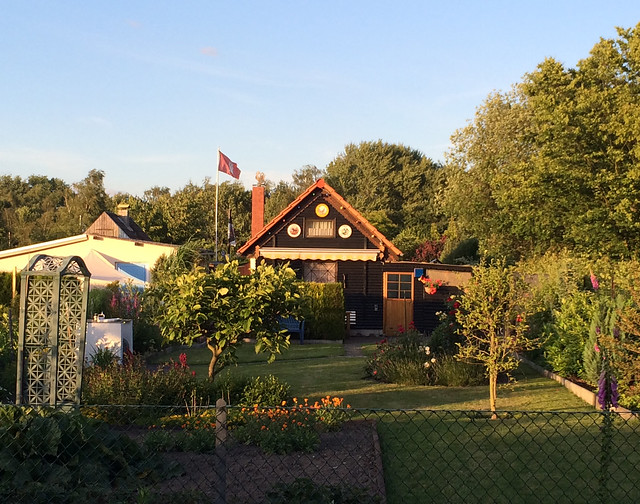
Until I came to Germany, the concept of Schrebergärten (allotment gardens) was unfamiliar to me. Could I be blamed? I grew up in the suburbs of a big city in North America. Every cookie-cutter house in my neighbourhood came equipped with a front yard and a backyard. Roughly one out of every three backyards on my street kept a modest garden of fruits and veggies and/or flowers. If you lived in an apartment, however, you reluctantly threw the notion of having a garden out the window.
Nowadays, most of the housing in average-sized German cities (i.e. not Berlin) consist of apartment blocks. We’re not talking buildings up to 30 storeys high, by the way. The tallest buildings that I’ve seen in Braunschweig are maximum 7 storeys high, if that. These apartments are occupied by people from all walks of life. Families prefer to live in apartments just as much as they prefer to live in houses in the suburbs. This isn’t Canada; not every German dreams of owning a house with a white picket fence and two cars parked on the driveway. Gott sei Dank for that.
The point I’m getting to is that because living in an apartment in Germany (or anywhere, for that matter) isn’t conducive to having one’s own garden, the Germans invented Schrebergärten so that city dwellers could have their own piece of nature just a stone’s throw away from home. Brilliant, no?
I’m pulling your leg. That actually isn’t the reason why Schrebergärten were invented. In a nutshell, these allotment gardens date back to a period of industrialization in Europe, a time when food security and survival were daily concerns. Sometime in the 19th century, a clever man named Dr. Schreber believed that children deserved a healthy environment in which to play. It was then that the concept of allotment gardens was born.
A typical German Schrebergarten today is pristine, well-maintained and photogenic. They have to be. There are strict German laws that forbid you from growing your grass too long! Kidding. But it is true that if you have a Schrebergarten you have to keep it in tiptop shape. And you cannot live there, as it’s not to be used for residential purposes.
Practically in my “backyard,” a large plot of land devoted to Schrebergärten exists just 5 minutes away from my home. It only takes me about 15 minutes to bike into the city so one can suppose these Schrebergärten aren’t too terribly far from where their tenants live. Hop on the Deutsche Bahn and no matter how short your journey is, there’s a good chance you’ll spot at least a few Schrebergärten while riding the German rails.
I took this photo while biking through my ‘hood a few weeks ago. If I cycle past the same allotment gardens this Friday and the weather’s nice, I’ll probably see families watching the football game outside. Germany’s playing France that day. It’s also World Cup 2014. #NBD
Those who don’t give a hoot about football may be barbecuing in their Schrebergärten on that day. Why? Because that's what Germans like to do. They like flocking to their Schrebergärten during the warm summer months so they can grill (aka barbecue) and have some beers with friends, do the gardening or simply lounge in the sun. Having a Schrebergarten is the cheaper alternative to having a house! Interested? It may be a while for those of you with green thumbs. Two words: waiting lists.
No comments:
Post a Comment